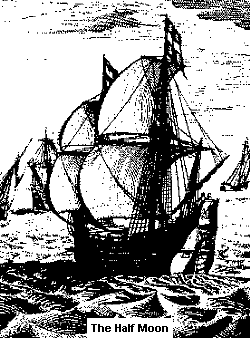| The Henry
Hudson Voyage of 1609 The first word on Point Pleasant "This is a very good Land to fall with, and a pleasant Land to see.‘’ Timelines | Pt. Pleasant Historical Society | Pt. Pleasant History | Images | Sites | Books | Tidbits | End | Send Mail  Written history of
the Point Pleasant area began on September 2, 1609. On that day Henry Hudson's
ship the Half Moon sailed northward along the New Jersey shore and past
Point Pleasant. It is possible, perhaps even likely, that other European
explorers had sailed by, but they left no records. Aboard the Half Moon
was a crewman named Robert Juet who kept a journal. For the most part it is a
matter-of-fact series of entries – detailing lands seen, tides, currents and
water depths. But occasionally Juet departed from his usual style to express an
opinion. And so it was that at the end of that day he became the first ever to
write of the charms of the Jersey Shore, proclaiming "This is a very good
Land to fall with, and a pleasant Land to see." Written history of
the Point Pleasant area began on September 2, 1609. On that day Henry Hudson's
ship the Half Moon sailed northward along the New Jersey shore and past
Point Pleasant. It is possible, perhaps even likely, that other European
explorers had sailed by, but they left no records. Aboard the Half Moon
was a crewman named Robert Juet who kept a journal. For the most part it is a
matter-of-fact series of entries – detailing lands seen, tides, currents and
water depths. But occasionally Juet departed from his usual style to express an
opinion. And so it was that at the end of that day he became the first ever to
write of the charms of the Jersey Shore, proclaiming "This is a very good
Land to fall with, and a pleasant Land to see."
It would be presumptuous to claim that Juet was referring exactly to the area that was to become known as Point Pleasant. But he was the first person to see it and write about it. And to the joy of publicists hundreds of years later, he liked what he saw. Little is known about Juet of Limehouse, England. He was probably an officer, but it is not known if his journal was an official ship's log or a private diary created by an inquisitive and literate sailor. It is silent on the subject of an attempted mutiny early in the voyage. In a subsequent trip with Hudson, Juet was implicated in a mutiny. He died in 1611 as that voyage was returning home. The following is the entry of the Juet Journal for the day the Half Moon sailed up the Jersey coast and into Raritan Bay for several days of rest and restocking before exploring the Hudson River. Notations are made of probable (at the time) unnamed landmarks: The first of September, faire weather, the wind variable betweene East and South, we steered away North North-west. At Noone we found our height to bee 39. degrees 3 minutes. Wee had soundings thirtie, twentie seven, twentie foure, and twentie two fanthomes, as wee went to the Northward. At sixe of the clocke wee had one of the twentie fanthomes. And all the third watch till twelve of the clocke at mid-night, we had soundings one and twentie, two and twentie, eighteen, and two and twentie fathoms, and went sixe leagues neere hand North North-west. The second [of September], in the morning close weather, the winde at
South in the morning; from twelve until two of the clocke we steered North
North-west, and had sounding one and twentie fathoms, and in running one Glasse
we had but sixteene fathoms, then seventeene, and so shoalder and shoalder until
it came to twelve fathoms. We saw a great Fire, but could not see the Land, then
we came to ten fathoms, whereupon we brought out tackes aboord, and stood to the
Eastward East South-east, foure Glasses. Then the Sunne arose, and we steered
away North againe, and saw the Land from the West by North, to the North-west by
North, like all broken Ilands. [The coast between Atlantic City and Little
Egg Inlet], and our soundings were eleven and ten fathoms. Then wee looft in
the shoare, and faire by the shoare, we had seven fathoms. The course along the
Land we found to be North-east by North. From the Land which we had first sight
of, until we came to a great Lake of water, as wee could judge it to bee, being
downed Land, which made it to rise like Ilands, which was in length ten leagues
[Barnegat Bay]. The mouth of that Lake hath many shoalds, and the Sea
breaketh on them as it is cast out of the mouth of it [Barnegat Inlet].
And from that Lake or Bay, the land lyeth North by East and wee had a great
streame out of the Bay; and from thence our sounding was ten fathoms, two
leagues from the Land. At five of the clocke we Anchored, and being little winde,
and rode in eight fathoms water, the night was faire. This night I found the
Land to hall the Compasse 8. degrees For [far] to the Northward of us we
saw high hils [Navesink Highlands, Staten Island hills or both]. For the
day before we found not above 2 degrees Variation. This is a very good Land to
fall with, and a pleasant Land to see. For Additional information:The New Jersey Historical Society, Newark, published Juet's Journal in 1959. It contains the entire text of the journal with notations and an introduction by well-known state historian John T. CunninghamTimelines | Pt. Pleasant Historical Society | Pt. Pleasant History | Images | Sites | Books | Tidbits | Top | Send Mail |